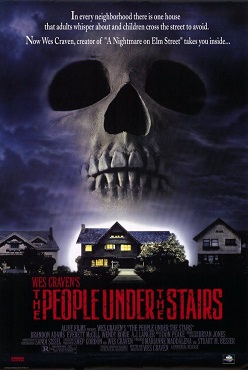Known to some as "the father of Freddy Kruegar", Craven already had made his mark in the horror film genre early on with the likes of 1972's The Last House on the Left and in 1977 with The Hills Have Eyes.
His unique vision did get him both an audience and positive critical response but it was that particular nightmare come to life via a certain deadly dream man that brought Craven into the mainstream.
A Nightmare on Elm Street became the starting point for one of the most enduring horror film franchises in Hollywood history, making New Line Studios "The House That Freddy Built", and for good reason. Not only this take on dreams make a significant change in the teen terror trend of the 1980s, it also launched the career of actor Robert Englund, the man who gave Craven's monster vividly frightening life:
Craven only directed two other films in the NOES series, each time making exciting new twists to his original terror tale. His last word on the whole Freddy phenomenon was neatly done in Wes Craven's New Nightmare, where the actors from the first movie were being haunted in the real world by the dream demon they helped to create.
That movie was vastly underrated by the fans when it arrived in theaters but critics gave it sterling reviews and it has turned into a cult classic of sorts. With it's meta story line and amazing visual tricks, Craven really breathed new life back into the almost formulaic Freddy:
Craven did venture outside of the horror realm, with thrillers like Red Eye and the 1999 drama Music of the Heart, which was the only one of his films to receive Oscar nominations.
However, some of his stand alone horror films did offer interesting insights into sociopolitical fears such as The Serpent and the Rainbow(which had the backdrop of Haiti's dictatorial government at the time in it's zombie story) and The People Under The Stairs, that took aim at the Reagan years.
The plot follows a young man named Fool who enters a notorious house in his neighborhood seeking treasure, only to find a gruesome twosome that called themselves "Mommy" and "Daddy" who were far from the ideal parents of TV sitcom land.
The metaphors for the class warfare and exploitation of minorities during that time period(which still holds up today, sadly enough) is neatly folded into the journey into an all too real heart of darkness for both Fool and the young girl he encounters, Alice. One of the hallmarks of Craven's writing is that he created flesh and blood characters for his audience to care about, not just stick figures ready to be gorily knocked down:
Most of this current generation of movie goers know Craven from the Scream series of films that flipped the slasher genre on it's head and into a meta knife wielded by the ever changing Ghost Face Killer. The film has been turned into a TV series, which is doing well enough to have a second season greenlit already.
Most of the Scream movies(with the pointed exception of Scream 3, a badly done entry indeed) made slick statements about not only how we perceive the cliches of any fictional formula but how it changes our outlook on reality as well. Take for example, the opening kill of Scream 2, set in a movie theater where a hapless audience member gets more than she bargained for.
At the time, no one thought of a movie theater as a dangerous place but, sadly due to real life, this scenario is more terrifying now than perhaps it was back then. The obliviousness of the engaged audience is what adds to the terror and while I'm not trying to trigger anyone, it is telling that this was a nightmare that people thought could only happen in a movie:
Granted, not every Wes Craven film hit the ball out of the park. For every horror home run, he did have his fair share of swings and misses, with the likes of Shocker, Vampire in Brooklyn and most recently, My Soul to Take.
However, the man did have a sense of humor about himself and his work, judging from the cameo appearances he made in Jay and Silent Bob Strike Back and Castle. Also, Craven's misfires were for the most part, attempts to do something different creatively. That's not something Hollywood often encourages anyone working in any genre to do and you have to give the man kudos for trying there.
The work of Wes Craven did inspire many of his fellow artists and will continue to do so long after his departure. He may have had doubts about his mark upon the genre yet many of us out there who appreciated the intelligent approach that Craven took to his films will make sure that those who come after us don't forget. Sorry to see you go, sir, but best wishes on your new adventure, which should be a wonderful dream come true in a better world:






No comments:
Post a Comment